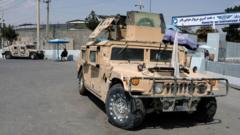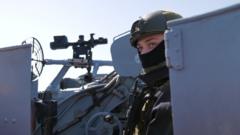An alarming report indicates that approximately half a million weapons and military equipment originally supplied by the U.S. to Afghan forces have been sold, lost, or smuggled to militant groups like al-Qaeda. The Taliban's controversial retention and handling of these arms raises concerns about security and stability in the region.
U.S. Weapons from Afghanistan Plunge into Militant Hands, Alarming Reports Reveal

U.S. Weapons from Afghanistan Plunge into Militant Hands, Alarming Reports Reveal
Analysis of the fate of military equipment and arms left behind in Afghanistan following the U.S. withdrawal highlights troubling trends of proliferation to extremist groups.
The BBC News has revealed a troubling trajectory for over half a million weapons that were left behind or abandoned in Afghanistan amid the Taliban's resurgence in 2021. Sources indicate that a significant amount of U.S.-funded military hardware has found its way into the hands of various militant groups, including affiliates of al-Qaeda.
According to a former Afghan official who spoke to the BBC on condition of anonymity, the Taliban seized nearly one million pieces of military equipment during their takeover, much of which included American-made firearms such as M4s and M16s. As Afghan troops surrendered or fled, an array of military assets was either abandoned or simply left behind by U.S. forces.
In a closed-door session of the UN Security Council's Sanctions Committee in Doha last year, it was reported that the Taliban admitted to losing track of half this equipment. An informant from the committee confirmed that sources had corroborated the claim, indicating that the whereabouts of roughly 500,000 items are currently unknown.
A recent UN report further elucidated that various al-Qaeda affiliates, including Tehreek-e-Taliban Pakistan and the Islamic Movement of Uzbekistan, are gaining access to the Taliban's captured arsenal or procuring it on the black market. The Taliban, however, dismissed claims of widespread smuggling and loss, with deputy spokesperson Hamdullah Fitrat stating that weapon security is prioritized.
The report drew attention to the fact that local Taliban commanders have been allowed to retain up to 20% of the seized U.S. weaponry, which has exacerbated the burgeoning black market in Afghanistan. A former journalist in Kandahar revealed that, for about a year post-Taliban takeover, an open arms market existed in the region, which subsequently transitioned to underground trading via platforms like WhatsApp. Wealthy individuals and local commanders are reportedly buying and selling both new and used U.S. weapons and equipment.
While the Special Inspector General for Afghanistan Reconstruction (SIGAR) reported a lower number of weapons, it acknowledged significant tracking challenges due to logistical issues over the years. The findings pointed criticism towards the Department of Defense and State Department regarding their efforts to manage and account for supplies left in Afghanistan.
Former U.S. President Donald Trump has made notable comments on reclaiming military equipment, citing an estimated $85 billion worth left behind, though this figure includes costs related to training and salaries that may distort the true nature of the value remaining in the country.
In a counter to Trump's rhetoric, Zabihullah Mujahid, the Taliban spokesperson, asserted that they rightfully acquired the weapons from previous administrations to safeguard their nation against future threats.
The Pentagon had previously indicated that disabled equipment remained post-withdrawal, yet the Taliban's impressive demonstration of military capability raises questions about operational advancements. Official reports indicate that many specialized items remain non-operational, but the Taliban continues to utilize more straightforward military assets effectively.
As discussions on reclaiming the weapons unfold, experts like former SIGAR chief John Sopko warned against it, stressing that the costs would far exceed any potential benefits. The distribution of these weapons to militant factions remains a significant cause for concern as the security landscape in Afghanistan shifts.





















